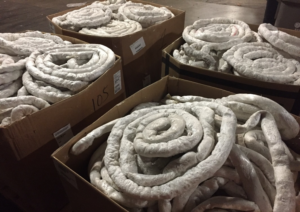“Styrofoam”, is a brand name for EPS, or Expanded Polystyrene. This material comes in many forms shapes, and sizes, but is typically found as protective packaging for appliances, furniture, electronics, and other types of items. Unfortunately, it is also the material of choice for large coffee chains such as Dunkin Donuts.
In a previous post, we shared our thoughts on San Francisco’s ban on Styrofoam and touched on the issue of recycling this material on a residential level. You may ask why this material is not accepted at the majority of recycling facilities, and why it is not readily recycled.
First – EPS can be readily recycled. The problem? It is very difficult to do it profitably, which is why it is difficult to locate a recycler interested in handling it.
Why is it difficult?
The problem is the weight. The exact reason that makes Styrofoam, or EPS so attractive to be used as packaging is the same reason it is difficult to recycle. Any profits derived from recycling this material is generated by the value – which is calculated “per pound”. With material this light in weight – it takes a very high value, (and quantity) to cover the cost of transportation, handling, and processing.
To overcome the issue of “light weight” EPS needs processing before being transported. This can significantly lower the per lb. cost of transportation, and makes it cost effective to recycle. There are two popular methods of densifying this material, either by heating and extrusion, (see picture), or by compressing into logs. Each method allows for cost effective shipping – typically to foreign countries for further processing.
Equipment used to perform this process can be costly – and must be performed at the point of generation to eliminate handling and transporting loose, bulky material any further than necessary.
In addition – EPS is a byproduct of oil. When oil prices are high, the value of this material increases. When oil prices drop the price of this material also drops.
So, should a large distribution facility, furniture warehouse or fish packing plant generate large amounts of EPS– it can be cost effective to place processing equipment on site. The processed EPS, now that it is densified, has value and is purchased by recyclers because it can be easily and efficiently handled and transported. Without this on site equipment it is not cost effective to recycle EPS.
We should also keep in mind that the benefits are not always derived strictly from the sale or value of the material. Considerable disposal costs can be reduced by removing this material from your waste stream, as light bulky materials such as this can be very expensive to dispose of.

